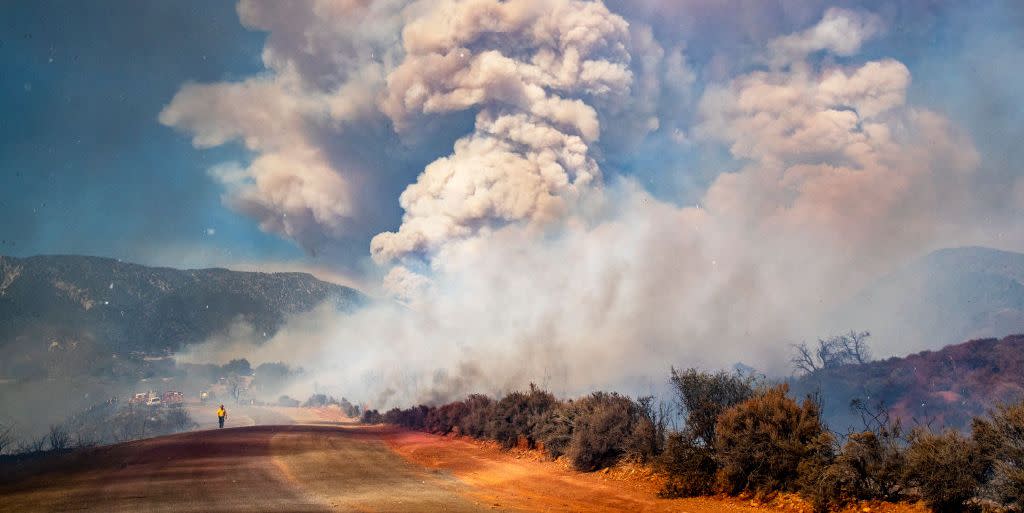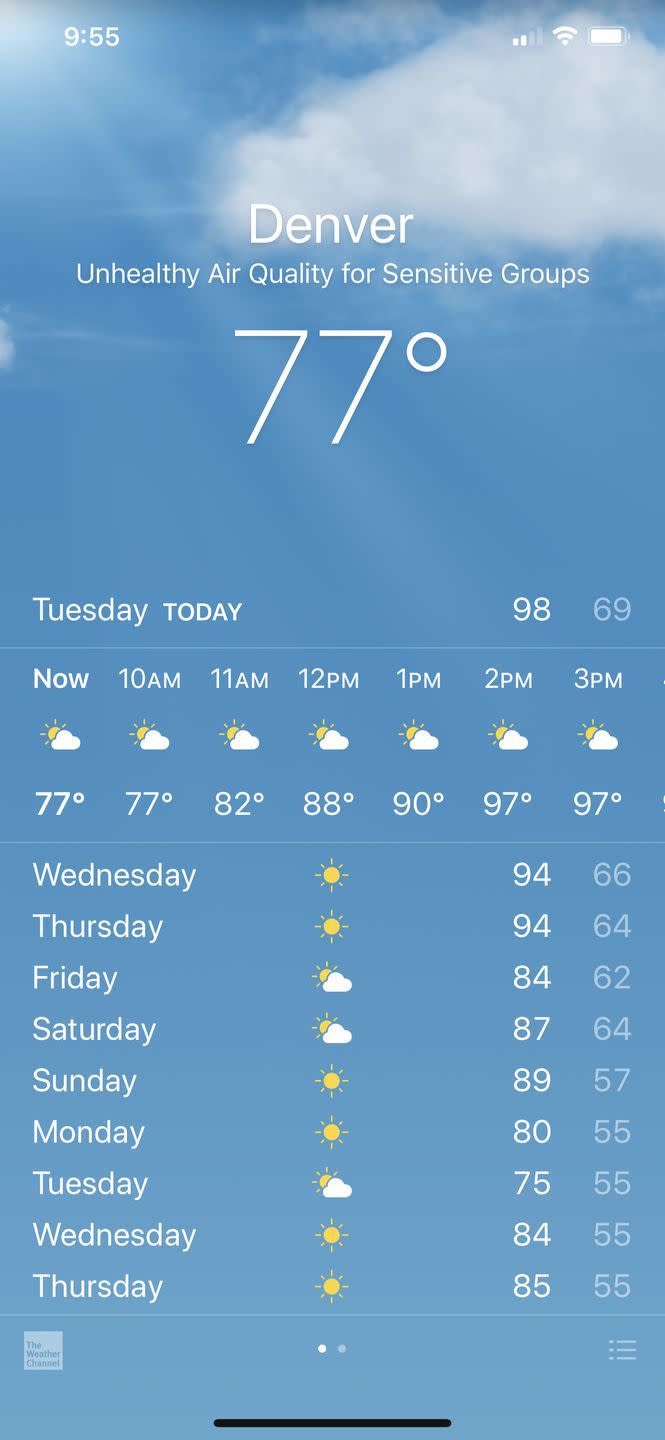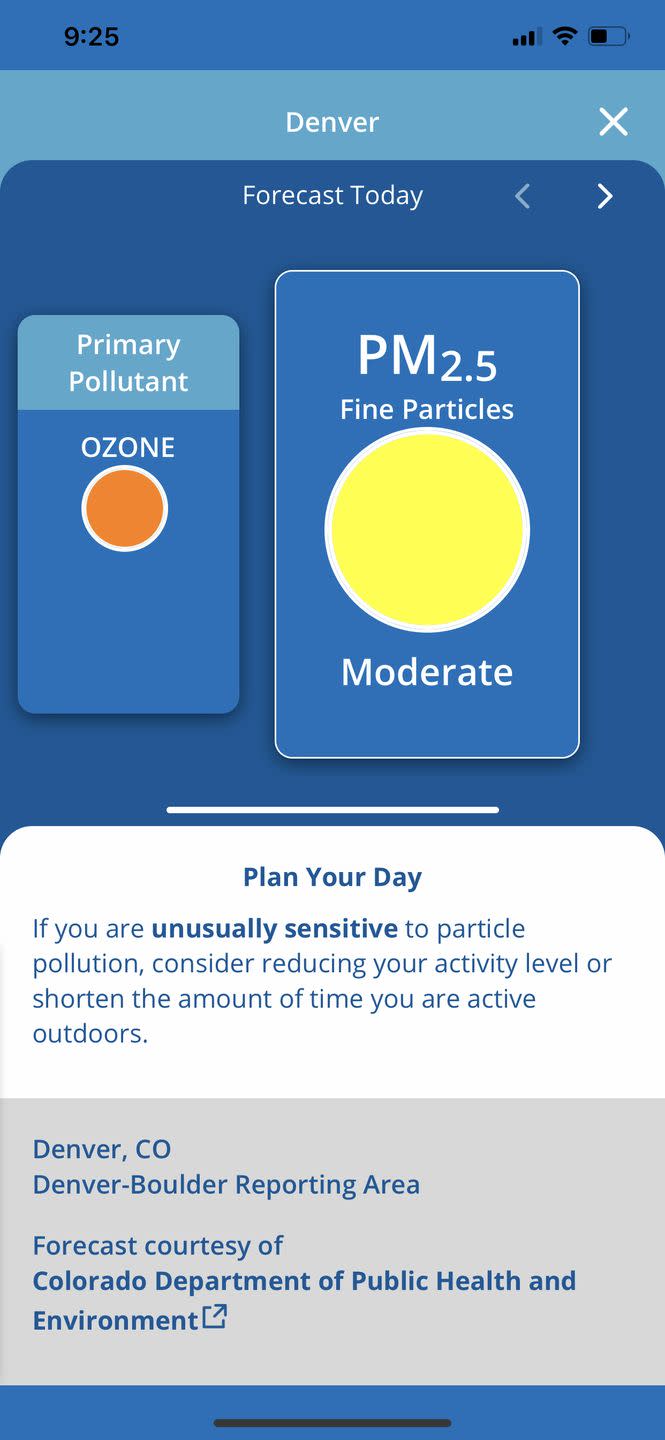Wildfire Smoke Is Everywhere In 14 States. Is It Safe to Ride?

The majority of Americans might agree that 2020 has been a flaming dumpster fire of a year. But in certain parts of the country, that descriptor hits a little too close to home right now.
There are currently over 90 wildfires blazing throughout the western part of the U.S., covering more than 1.8 million acres through Alaska, Arizona, California, Colorado, Idaho, Montana, Nevada, New Mexico, Oregon, South Dakota, Texas, Utah, Washington, and Wyoming.
And it’s not just those states that are affected; wildfire smoke can travel hundreds—even thousands—of miles, says Edward Avol, a professor in the environmental health division of the Department of Preventive Medicine at the University of Southern California Keck School of Medicine. So even if your skyline isn’t hazy, you might be vulnerable to the effects of that smoke.
That’s because athletes who are working out take in a significant amount of air compared to people who aren’t working out. “If you’re just sitting quietly in a room, you might be breathing in eight to ten liters of air per minute,” says Avol. “If you’re [exercising] and working hard, you might be breathing 150 or 180 liters per minute.”
And you’re not just going to be sucking wind; you’re going to be inhaling combusted and reactive materials such as dirt, wood, paint, solvents, rubber, and insulation, in addition to gases if riding through wildfire smoke, says Avol. Not quite the fuel your lungs and muscles are screaming for, right? Here’s how to navigate the situation.
How to Look Up the Air Quality In Your Area—And What It Means
If you have an iPhone, you may have opened the weather app at some point or another to see an alert under your location saying “Unhealthy Air Quality” or “Unhealthy Air Quality for Sensitive Groups.” You may have even ignored it.

But that warning is based on the Air Quality Index (AQI), a numerical scale from the Environmental Protection Agency that standardizes health risks and exposures to five pollutants regulated by the Clean Air Act: ground-level ozone, particle pollution (also known as particulate matter), carbon monoxide, sulfur dioxide and nitrogen dioxide.
Any number over 100 is considered unhealthy for sensitive groups (the elderly, children, and people with heart or lung diseases may be vulnerable), while the general public may start to experience health effects when it’s over 150. When that number tips over 200, that increases the risk of health effects for everyone. “This is meant to be a generalized guide as to what we might be exposed to and how to adjust our behavior accordingly,” says Avol.
Health concerns are particularly linked to fine particulate matter with diameters less than 2.5 micrometers (PM2.5). Particles can vary from the size of a grain of sand or dust to those you can’t even see with the naked eye, says Avol. “These microscopic particles are so small, they get past your body’s defense mechanisms,” he explains. “When you’re breathing heavily, they get drawn deep into your lungs, into the blood/air exchange in your alveoli, where they can pass into the bloodstream and cause long-term health issues.” (On the EPA app—available on Apple and Google—or PurpleAir.com, you can see the specific risk from PM 2.5 particles.)

“People who have pre-existing issues like asthma, respiratory conditions like hyperreactive airways, or even allergies can find spending even a brief amount of time in smoky or polluted air to be problematic,” says Avol. But even those who don’t suffer from any of those ailments should be aware of the long-term ramifications of riding in that kind of environment.
So, Is It Safe to Ride When It’s Smoky?
The short answer: Probably not. “There’s a risk/reward calculation that you have to make,” says Jason Fitzgerald, a USATF-certified running coach and founder of Strength Running in Denver.
But cyclists are nothing if not dedicated to their training plans (even if there are no races on deck), so if you are going to go out for a ride, it’s probably best to go short and easy, says Fitzgerald. The damages from air pollution are more pronounced when you’re taking in a higher volume of air, which could mean riding for a long time or riding really hard—anything that will really increase your respiration rate.
And if you decide to ride, wear a mask. “Thanks to COVID-19, we’ve been sort of pre-sensitized to wearing masks and personal protection,” Avol says. “A mask with a filter can help block some of that particulate matter.”
You should know that just a 30-minute, moderate-intensity aerobic training session could produce high levels of pollutant inhalation in certain areas, research published in the International Journal of Environmental Research and Public Health found. And, in the short-term, high levels of air pollutants may lead to decrease in the maximal oxygen consumption (VO2 max), according to a paper published in 2019 in the journal Scientific Research and Essays, which would make exercising at your normal pace feel much harder.
If you can see and smell the smoke, consider that two strikes against your desire to ride outside, Avol says. But even if things look clear, before you ride, you should check the AQI score to figure out whether it’s even a good idea, adds Fitzgerald. “If you’re actually feeling the effects of pollution in the air when you’re riding— if you’re actively feeling like your throat is burning, or your eyes are watering, or you’re sneezing—that strikes me as concerning.” It’s best to bag it and head home.
It’s not just your cycling performance that could be impacted. The American Heart Association has warned that “exposure to PM2.5 over a few hours to weeks can trigger cardiovascular disease-related mortality and nonfatal events; longer-term exposure (i.e. a few years) increases the risk for cardiovascular mortality to an even greater extent ... and reduces life expectancy ... by several months to a few years.”
[Download the All Out Studio App for more amazing at-home workouts!]
More recent research has shown that even small increases in the amount of PM2.5 in the air increased respiratory and cardiovascular hospitalization and mortality, according to a 2017 study published in the International Journal of Public Health; the negative effects of PM2.5 were also found to be more persistent than those of other pollutants, according to a 2015 review in the British Medical Journal.
What to Do Instead
Hopping on the trainer isn’t your only option. You can do aerobic cross training like HIIT workouts inside; you can focus on strength training; you can even do dynamic flexibility exercises and foam rolling (you know you’ve been meaning to do that). “You should always be working off this hierarchy of: If you can’t do the ideal thing, then what’s the next best thing? If you can’t do that, then what’s the next best thing?” says Fitzgerald.
If there’s anything 2020 has taught us, it’s to embrace flexibility when it comes to...pretty much everything right now. Use this time wisely: There’s a lot of opportunity to be had when you can’t go riding, but you still have that time blocked off, says Fitzgerald. “That’s a helpful way of reframing a bad situation into something that you might be able to use productively.”
You Might Also Like

